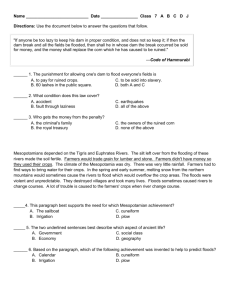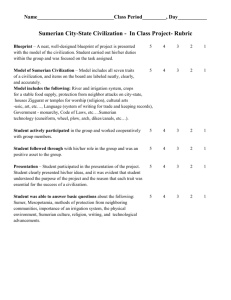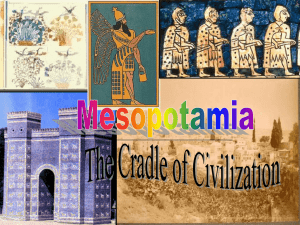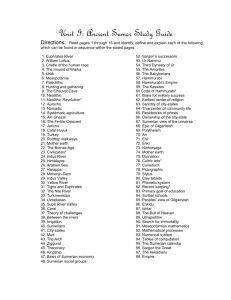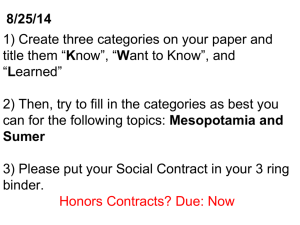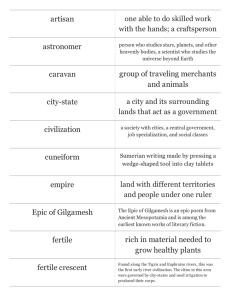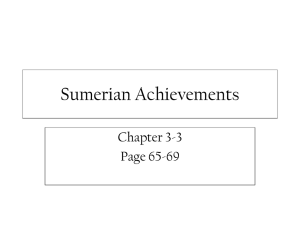ANE: Sumeria Notes
advertisement
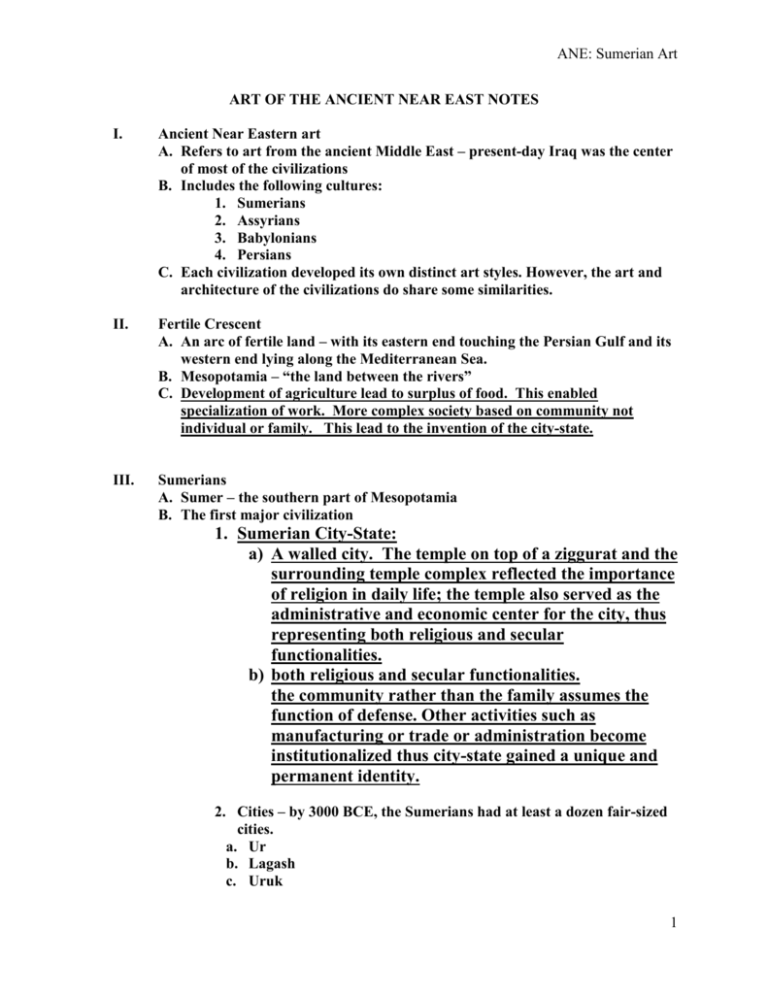
ANE: Sumerian Art ART OF THE ANCIENT NEAR EAST NOTES I. Ancient Near Eastern art A. Refers to art from the ancient Middle East – present-day Iraq was the center of most of the civilizations B. Includes the following cultures: 1. Sumerians 2. Assyrians 3. Babylonians 4. Persians C. Each civilization developed its own distinct art styles. However, the art and architecture of the civilizations do share some similarities. II. Fertile Crescent A. An arc of fertile land – with its eastern end touching the Persian Gulf and its western end lying along the Mediterranean Sea. B. Mesopotamia – “the land between the rivers” C. Development of agriculture lead to surplus of food. This enabled specialization of work. More complex society based on community not individual or family. This lead to the invention of the city-state. III. Sumerians A. Sumer – the southern part of Mesopotamia B. The first major civilization 1. Sumerian City-State: a) A walled city. The temple on top of a ziggurat and the surrounding temple complex reflected the importance of religion in daily life; the temple also served as the administrative and economic center for the city, thus representing both religious and secular functionalities. b) both religious and secular functionalities. the community rather than the family assumes the function of defense. Other activities such as manufacturing or trade or administration become institutionalized thus city-state gained a unique and permanent identity. 2. Cities – by 3000 BCE, the Sumerians had at least a dozen fair-sized cities. a. Ur b. Lagash c. Uruk 1 ANE: Sumerian Art 3. Specialized Workers: Development of agriculture enabled specialization. More complex society based on community not individual or family. Invention of the city-state. a. Rulers and Priests directed communal activities. Overhead: The ongoing administrative expenses of a business which cannot be attributed to any specific business activity, but are still necessary for the business to function. Question workers will ask themselves in an ANE city-state: Why do I need to sweat working in the field/shop/studio and the priests and rulers don’t? b. Farmers created a surplus of crops. c. Merchants sold goods in the cities. d. A new class of artisans – skilled workers made goods by hand 4. Writing a. Cuneiform – from the Latin word cuneu meaning “wedge” b. Cuneiform: beginning of writing and thus civilization. Allowed sophisticated, complex grammatical constructions. c. Cuneiform is a wedge-shaped written language. It is one of the earliest languages. Ancient Near Eastern works of art often include cuneiform inscriptions. d. Read top down, right to left. e. Form based on stylus shape: The way art looks is dependent on the technology available. f. Started as pictographs (simplified pictures for words) and evolved into more simplified cuneiform. g. Provides archaeologists and art historians with valuable information about the art h. Cuneiform found in distant Middle East city-states. Lots of trade because Mesopotamia was poor in metal, stone, wood. i. Literature: Epic of Gilgamesh: exploits of a legendary king of Uruk and slayer of the monster Huwawa C. Ur – a brief tour 1. Today the desert sands completely cover what was once a thriving city (cautionary example of overuse of natural resources). But, in ancient times some 4,000 years ago, Ur was surrounded not by desert but by irrigated fields. a) Fields of grain b) Mud-brick wall c) Narrow unpaved streets d) Crowded bazaar 2. Ur’s temple complex 2 ANE: Sumerian Art a) ZIGGURAT - solid, stepped platform, sometimes with several levels. A ramp led to the top of the ziggurat which usually held a temple. b) Ziggurats were constructed from sun-dried mud bricks because stone was not readily available for building. c) Many Sumerian cities had ziggurats d) Ziggurats proclaimed the wealth, prestige, and stability of the city’s rulers and glorified its protective gods. e) Ziggurats served as bridges between heaven and earth, a meeting place between humans and the god(s) f) The temples on top of ziggurats were known as “waiting rooms” because priests and priestesses waited there for the gods and goddesses to reveal themselves. 1. Temples were not for big groups of people, only for priests and leaders. Many rooms in temple but central room (=cella) with a stepped altar was set aside for the god g) Ziggurats are NOT pyramids. Note difference between fired and sun-dried mud brick. h) Compare and contrast a Ziggurat with an Egyptian Stepped Pyramid. i) Examples: White Temple and Ziggurat, Uruk (Warka, Iraq), 3200 – 3000 BCE; Ziggurat of King Ur-nammu, Ur, ca. 2100 BCE 1. Stairway up one side of ziggurat. 2. White Temple: oriented to cardinal points 3. Does not lead to temple door. 4. Need to turn 2 – 3 angles to reach temple door = bentaxis plan (standard for Sumerian temples). 5. Babylonian ziggurat, 270’ tall, Biblical Tower of Babel, humans’ insolent pride. D. Important Sumerian works of art Stylistic conventions of Sumerian Art: rigidly frontal symmetry, abnormally large eyes, and tightly clasped hands. Uni-brow. 3 ANE: Sumerian Art Sumerian relief sculpture uses the convention of showing figures in profile with shoulders full frontal, and the poses are regularized and repeated. Eyes are large, and tiny hands are often clasped. Shows importance of religion and devotion in society. 1. Female Head, Marble, possibly goddess Inanna, Uruk, 3200 – 3000 BCE a) Inanna, goddess of love and war. Later called Ishtar b) Marble, very expensive, needed to be transported c) Hollowed eyes & Uni-brow for inlay (shell or stone) d) Head groove for wig, possibly gold leaf e) Soft modeling of features f) Head found in precinct of Temple of Innana, maybe a portrait of a priestess? g) Head probably on top of body (wood?) clothed in jewels and fabrics 2. Warka Vase, Alabaster, Uruk, 3200 – 3000 BCE a) Alabaster, expensive, transported b) In Inanna temple, depicts religious festival in honor of goddess. c) Oldest example of Sumerian narrative art (tells a story) d) Composition divided into bands (Registers or Friezes) 1. Innovation: orders the composition; pre-historic pictures had figures placed haphazardly. 2. Figures in each register stand on ground line (horizontal base of each register). 3. Registers still used in comic strips e) Registers bottom to top: 1. Crops on banks of water (river) 2. Alternating ewes and rams (female/male):fertility, good crops and herds 3. Naked men carrying jars and baskets overflowing i. Votive offering: gift of gratitude to deity in thanks or to honor a vow 4. Top is tallest register (hierarchy of scale) with Inanna (or Priestess) wearing horns receiving offerings from nude male. Next to goddess is male (partial) that may be king-priest. Maybe a symbolic marriage. Exalt king. f) All figures 1. no overlapping 2. all body parts are shown via composite of frontal and profile views. 4 ANE: Sumerian Art 3. Conceptual, captures idea of body not fleeting aspects of figure 3. VOTIVE FIGURES- Eshnunna Statuettes, (Tell Asmar, Iraq), ca. 2700 BCE, carved gypsum inlaid with shell and black limestone. a) – statues made as an act of worship to the gods b) Votive figures represent ordinary Sumerians c) Different sizes ranging from 12 inches to 30 inches d) Usually contain a few basic characteristics: 1. Huge eyes – show that the Sumerian is attentive to the gods. Eyes are usually made from inlaid stones. Empty eyes sockets mean that the stones have fallen out. 2. Stylized, uni-brow common feature to have one very long eyebrow 3. Hands are usually clasped together – sometimes praying, usually holding a cup – priests could pour offerings of drink into the cup. Small Hands – why? 4. Rigid, upright pose – attentiveness to the gods 5. Stylized hair – wavy, curly hair that is typical of ancient Near Eastern art. Some of the male figures have bald heads 6. Sheepskin kilts or tunics 7. Eternal wakefulness and duty 8. Votive figures acted as surrogate supplicants for the Sumerians. You could place your surrogate supplicant (substitute worshipper) in the temple instead of you being there all day worshipping. e) Imagine what you could do if you had your own surrogate supplicant. 4. Stele of Vultures, Girsu (Telloh), Iraq, Limestone, ca. 2600 – 2500 BCE. Several pieces. a) Stele: Carved stone slab commemorating historical event or sometimes a grave. b) Labeled historical narrative crowed with cuneiform inscriptions. c) So effective because words and pictures combined. d) Composed with registers. e) Celebrates victory of Eannatum, ensi (ruler, king) of Lagash over city-state Umma. f) Portion depicts vultures carrying off body parts. g) Shows 1. Local god, Ningirsu, holding tiny soldiers in a net and beating them with a mace. 2. Infantry being lead by Eannatum (hier. Of scale) trampling over naked bodies. 5 ANE: Sumerian Art 3. Lives lost and Eannatum wounded. 4. Outcome not in doubt due to Ningirsu. h) Historical document: Words and pictures provide info about warfare and place of ensi in society 1. Ensi born from Ningirsu’s semen. Divinely chosen to lead in war and peace. 5. Another important Sumerian work of art --- STANDARD OF UR (ca. 2600 BCE) a) Ur is home of biblical Abraham b) Discovered by British archaeologist Leonard Woolley in the early 1930s from Ur burial chambers c) It is a wooden box with two short sides and two long sides called the War and Peace sides respectively d) It has a small hole at the bottom which made Woolley conclude that maybe it was put on a pole and used in parades much like a flag (standard) e) The sides are ornamented in mosaic with limestone, shell, and lapis lazuli (precious blue stone from Afghanistan) set in black bitumen paste f) Each side contains historical figures depicted in three horizontal rows called REGISTERS g) REGISTERS – horizontal bands used in art to organize the picture, often used for conveying a narrative (story) h) Standard of Ur reads from left to right and from bottom to top i) Standard of Ur is one of the first narrative works of art in human history j) WAR SIDE 1. First register - Four war chariots each drawn by a team of onagers (wild asses) 2. The pace of the onagers accelerates from a walk to a gallop 3. Notice the chariots have wheels and that they are running over the enemy soldiers 4. Second register – infantry advances from left to right. Seven soldiers wear copper helmets and short tunics made of wool. 5. Note their prisoners on the right – the army of Ur forces them to walk naked as a sign of humiliation 6. In the top register, the figure of the ruler is taller than everyone else. This is called HIERARCHICAL SCALE. HIERARCHICAL SCALE denotes status by making 6 ANE: Sumerian Art important figures larger and more prominent than less important figures. 7. The two processions converge on the rule of Ur – he is coming to survey the prisoners. j. PEACE SIDE of the Standard of Ur 1. Bottom register shows people of Ur or conquered people carrying goods with teams of onagers (wild Asian ass) 2. Second register depicts more people walking with wooly rams (good for textiles), carrying fish (Tigris and Euphrates Rivers), and walking with livestock 3. Top register depicts a royal banquet with the king and his nobles. It still contains HIERARCHICAL SCALE. It has interesting details such as animal hoofed chairs. A singer and musician in the right corner entertain the banqueters. 4. Discussion Question: What message(s) does the Standard of Ur convey? How does it convey its message(s)? 6.Bull’s Head Lyre a. Made out of wood, musical instrument. b. Notice the bright blue beard – this is made from a stone known as lapis luzuli c. Notice the mosaic panel below the bull’s head d. The panel is divided into REGISTERS e. Contains COMPOSITE CREATURES – figures that blend human and animal features – composite features are common in the ancient world. Shown in profile f. Top register is heraldic composition: symmetrical on either side of central figure g. Man in top register and scorpion man shown in COMPOSITE VIEW (note different than composite creature). Conceptual representation, shows all parts and in most recognizable and characteristic way. A convention of representation in which part of a figure is shown in profile and another part of the same figure is shown frontally; also called twisted perspective. h. Feast is a parody of kind of feast in Standard or Ur or creatures in the land of the dead? represents heraldic composition and burlesquing a regal feast 7. Cylinder Seals a) prized possessions indicating status and served as devices to identify ownership and prevent unauthorized use as well as a “signature”. b) Stamps or Cylinders (lapis lazuli) 7 ANE: Sumerian Art c) Used for ID d) Contain useful information about dress and social norms e) When stamped or rolled into wet clay creates raised impression (relief) 8

